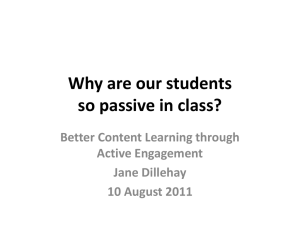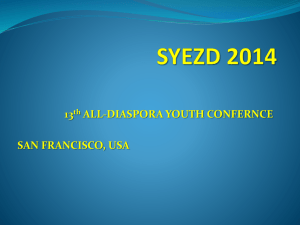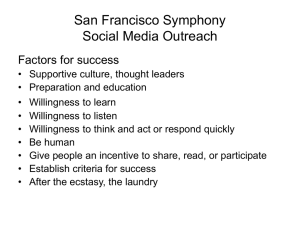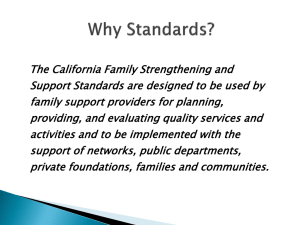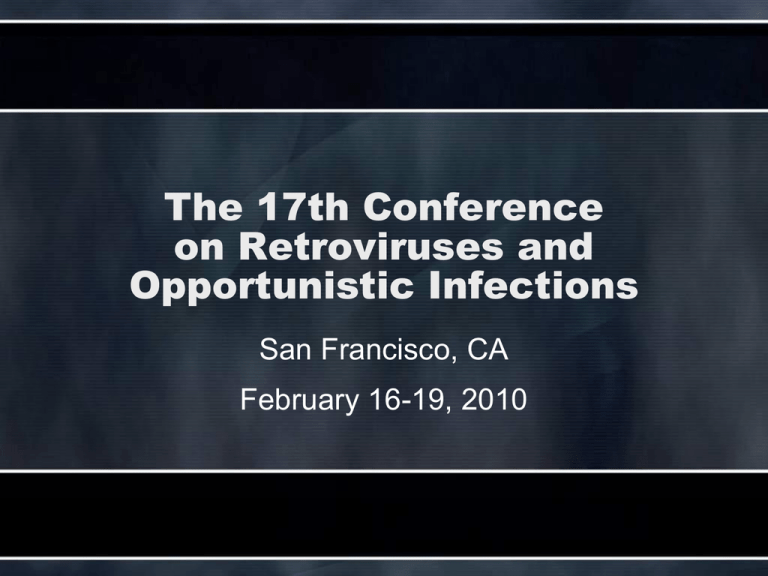
The 17th Conference
on Retroviruses and
Opportunistic Infections
San Francisco, CA
February 16-19, 2010
Studies in ARV-Naïve Patients
When to Start
Rick Elion, MD
Associate Professor, George Washington University
School of Medicine
Washington, DC
Life Expectancy of
HIV-Positive Patients
Comparison of life expectancy of
Athena cohort patients to general
population (n=4174)
Age at week 24, country of birth
and stage B symptoms were
associated with a higher risk of
death
Expected life years remaining at
age 25 was 53.1 (44.9-59.5) for
general population and 52.7 for
asymptomatic HIV+ patients
The modeled life expectancy of
patient presenting at an older age
and women were slightly lower
that general population
van Sighem A, et al. 17th CROI; San Francisco, CA; February 16-19, 2010. Abst. 526.
Years Years
of Life of
Remaining
Life Remaining
Age at time of death
Years lived
Remaining Life Years
Age at 24 weeks (years)
General Population
Asymptomatic HIV+ Patients
Increasing CD4 at First Presentation
but Patients Still Present Late to Care
NA-ACCORD analysis
regarding median CD4
on first presentation from
1996-2007 (N=35,009)
Median CD4 on
presentation has
increased from 234 to
327 cells/mm3 (P<0.01)
Proportion of CD4 ≥350
cells/mm3 at first
presentation has
increased from 34% to
47% (P≤0.01)
Althoff K, et al. 17th CROI; San Francisco, CA; February 16-19, 2010. Abst. 982.
Linkage of Testing to Routine Care
Leads to Earlier Diagnoses
Washington DC has an
estimated HIV
seroprevalence of 3%
2006 DOH expanded HIV
testing to be included in
routine care with improved
clinical linkages
From 2004 to 2006, HIV tests
increased from 19,000 to
73,000
Among newly diagnosed,
median CD4 count increased
57%
Castel A, et al. 17th CROI; San Francisco, CA; February 16-19, 2010. Abst. 34.
p<0.001
1,378 patients at 10 US clinics
followed from 1996-2007
Median Peak CD4 was
progressively higher for
specific CD4 strata (p<0.001)
Multivariate analysis: Increased
mortality with CD4 < 50
(HR=4.6) and CD4 50-199
(HR=2.6) compared to ≥200
cells/mm3
Lower BL CD4 at initiation also
associated with increased risk
of death from non-AIDS-related
causes.
Palella F, et al. 17th CROI; San Francisco, CA; February 16-19, 2010. Abst. 983.
Median CD4+ cell count
CD4 at Initiation of ARV Therapy
Predicts Extent of CD4 Recovery
Correlation Between Nadir CD4+ T-cell Count
and Cardiovascular Risk
Cross-sectional study of 80 HIV+
men on ARV Tx with undetectable
HIV RNA
Median age 47 years, nadir CD4+
T cell count 180 cells/mm3
CV risk assessed using arterial
stiffness (AS) by pulse wave
analysis and carotid-femoral pulse
wave velocity (PWV)
Nadir CD4 count <350 cell/mm3
independently associated with
significant increase in AS and PWV
Other significant determinants of
PWV in multivariate analysis
included age, systolic and diastolic
BP, and diabetes.
AS was not affected by the duration
ARV
or 16-19,
exposure
Ho J, etof
al. 17th
CROI; San therapy
Francisco, CA; February
2010. Abst. 707. to PIs
Significant determinants of PWV on
Multivariate Analysis
Beta (95%)
P-value
Age
0.48
(0.26-0.70)
<0.001
Systolic blood
pressure
0.44
(0.12-0.76)
0.007
Diastolic blood
pressure
-0.29
(-0.53-0.04)
0.03
Diabetes mellitus
2.38
(1.38-3.38)
<0.001
Nadir CD4 <350
0.58
(0.15-1.01)
0.008
Neurocognitive Disorders Associated
with Nadir CD4 Counts
Multicenter cohort study
(CHARTER) of 1526 pts
evaluating HIV-associated
Neurocognitive Disorders
(HAND)
Complex testing consistent
with defined criteria used to
determine HAND
603 had HAND (without
a substantial confounder);
726 not impaired
Most with HAND (n=428)
were asymptomatic and only
a few (n=27) had frank
dementia
Multivariate analysis: Higher
CD4 nadir associated with
lower risk of HAND
Ellis R, et al. 17th CROI; San Francisco, CA; February 16-19, 2010. Abst. 429.
Odds Ratio for Cognitive Impairment by CD4 Nadir
Odds Ratio
1.1
1
0.9
0.8
0.7
0.6
0.5
0.4
0.3
<50
50-199
200-349
≥350
CD4 Nadir
Odds Ratios for NP Impairment
N
Impaired
Unimpaired
1525
799
726
Nadir CD4 < 50
387
222
165
1.00 (reference)
Nadir CD4 50-199
481
258
223
0.86 [0.66, 1.13]
Nadir CD4 200-349
370
189
181
0.78 [0.58, 1.03]
Nadir CD4 ≥350
287
130
157
0.62 [0.45, 0.84]
589
320
269
Nadir CD4 < 50
185
112
73
1.00 (reference)
Nadir CD4 50-199
214
118
96
0.80 [0.54, 1.19]
Nadir CD4 200-349
133
64
69
0.60 [0.39, 0.95]
57
26
31
0.55 [0.30, 0.99]
All
On ART, Plasma VL <50c/ml
Nadir CD4 ≥350
OR (95% CI)
Impact of Expanded HAART Availability
on New HIV Diagnoses
Evaluation of association between expansion of ART coverage, population level
HIV viral load and new HIV diagnoses in British Columbia
Expansion of ART access in 2004-2009 associated with a significant decline in
new HIV diagnoses
After 2007, ~50% decrease in new HIV diagnoses among IDU occurred and
associated with a decline in proportion of HIV+ IDU with plasma HIV-1-RNA level
>1500 copies/mL from ~50% (2000-2004) to ~20% (2009) (P<0.001)
New HIV + Diagnoses (All)
Active on HAART
New HIV + Diagnoses (IDU)
Montaner J, et al. 17th CROI; San Francisco, CA; February 16-19, 2010. Abst. 88LB.
Studies in ARV-Naïve Patients
What to Start
Joseph Eron, MD
Professor, University of North Carolina School of Medicine
Chapel Hill, NC
Elvitegravir and Cobicistat (GS-9350):
Design of the Two Phase 2 Studies
EVG/GS-9350/TDF/FTC + placebo
Treatment-naïve
HIV RNA ≥5,000 copies/mL
CD4 cells >50 cells/mm3
No Resistance to
NRTIs
NNRTIs
PIs
HBV- and HCV-negative
n=48
2:1
EFV/TDF/FTC + placebo
n=23
GS-9350 + placebo
2:1
ATV + FTC/TDF
n=50
RTV + placebo
ATV + FTC/TDF
n=29
• Randomization stratified by HIV RNA (≤ or >100,000 copies/mL)
• Primary Endpoint: Proportions with HIV RNA <50 copies/mL at Week 24
• 48-week trials
Cohen C, et al. 17th CROI; San Francisco, CA; February 16-19, 2010. Abst. 58LB.
Baseline Characteristics
Cohen C, et al. 17th CROI; San Francisco, CA; February 16-19, 2010. Abst. 58LB.
Primary Endpoint: Percentage with HIV
RNA <50 copies/mL (ITT M=F)
RTV vs. GS-9350
EVG/GS-9350 vs. EFV
Week 24 stratum-weighted difference
-1.9% (95% CI: -18.4% to 14.7%)
100
90%
83%
80
60
40
20
0
100
Percentage with
HIV RNA <50 copies/mL
Percentage with
HIV RNA <50 copies/mL
Week 24 stratum-weighted difference
+5% (95% CI: -11.0% to 21.1%)
60
40
20
0
0
4
8
12
16
20
24
Week
EVG/GS-9350/TDF/FTC
EFV/FTC/TDF
Cohen C, et al. 17th CROI; San Francisco, CA; February 16-19, 2010. Abst. 58LB.
86%
84%
80
0
4
8
12
16
Week
20
24
RTV + ATV + TDF/FTC
GS-9350 + ATV + TDF/FTC
Adverse Events >5% Related
to Randomized Drug
Cohen C, et al. 17th CROI; San Francisco, CA; February 16-19, 2010. Abst. 58LB.
A5202: Study Design
TDF/FTC QD
HIV-1 RNA ≥1000 c/mL
Any CD4+ count
≥16 years of age
HIV+, ART-naïve
(N=1857)
Stratified by screening HIV-1 RNA
(< or ≥100,000 c/mL)
ABC/3TC Placebo QD
ABC/3TC QD
TDF/FTC Placebo QD
TDF/FTC QD
ABC/3TC Placebo QD
ABC/3TC QD
TDF/FTC Placebo QD
Daar E, et al. 17th CROI; San Francisco, CA; February 16-19, 2010. Abst. 59LB.
EFV
QD
EFV
QD
ATV/r
QD
ATV/r
QD
A5202: Overall Baseline
Characteristics
EFV
(n=465)
ATV/r
(n=463)
ABC/3TC
Median Age (years)
Male
Race/Ethnicity
White non-Hispanic
Black non-Hispanic
Hispanic
EFV
(n=464)
ATV/r
(n=465)
TDF/FTC
37
79%
38
84%
39
85%
39
83%
38%
35%
23%
41%
33%
23%
43%
33%
22%
40%
32%
24%
4.7
4.6
4.7
4.7
Median CD4 (cells/mm3)
History of AIDS
225
19%
236
15%
234
15%
224
15%
Genotype at screening*
43%
47%
47%
40%
HCV positive
6%
9%
9%
7%
Median HIV RNA (log10 c/mL)
* Required for those with recent infection, otherwise optional
Daar E, et al. 17th CROI; San Francisco, CA; February 16-19, 2010. Abst. 59LB.
A5202: Time to Virologic Failure in Patients with
Baseline HIV RNA >100,000 c/mL
Probability of No Virologic Failure
TDF-FTC (26 events)
ABC-3TC (57 events)
P<0.001, log-rank test
Hazard ratio, 2.33 (95% CI, 1.46-3.72)
Results similar between EFV and ATV/r arms
Sax PE, et al. NEJM 2009;361:2230-2240; Daar E, et al. 17th CROI; San Francisco, CA; February 16-19, 2010. Abst. 59LB.
HIV RNA <100,000 c/mL
HR 1.26
(0.76,2.05)
HR 1.23
(0.77,1.96)
ATV/r
EFV
Percent without Virologic Failure
Percent without Virologic Failure
Probability of No Virologic Failure and
CD4+ Change at Week 96
CD4 Change (cells/mm3)
P=
Daar E, et al. 17th CROI; San Francisco, CA; February 16-19, 2010. Abst. 59LB.
All Subjects
HR 1.13
(0.82,1.56)
HR 1.01
(0.70,1.46)
ABC/3TC
TDF/FTC
250 251
252 221
0.89
0.002
A5202: Percent of Virologic Failures with
Emergence of Major Resistance Mutations
ABC/3TC
Percent
76
TDF/FTC
63
P<0.0001
P=0.0003
48
54
Viral failures
No baseline resistance (N)
P<0.0001
P=0.046
P-values: ATV/r vs. EFV (among failures)
*Major mutations defined by IAS-USA (2008) list plus T69D, L74I, G190C/E/Q/T/V for RT and L24I, F53L, I54V/A/T/S and G73C/S/T/A for PR
Daar E, et al. 17th CROI; San Francisco, CA; February 16-19, 2010. Abst. 59LB.
ACTG 5208: Study Design
Octane Trial II
Open-label comparison of NVP and LPV/r, both combined with TDF/FTC
Median F/U (weeks)
ART-naïve women with
CD4+ <200 cells/mm3
(N=500)
LPV/r +
TDF/FTC
120
Two primary endpoints:
• Time to VF/death
• Time to discontinuation
NVP +
TDF/FTC
116
Only African sites; partner study to same comparison in women who had received sdNVP
Baseline Characteristics
NVP (n=249)
LPV/r (n=251)
Age
35
34
CD4
121
121
VL
5.16
5.15
ZDV exp
2%
1%
BL NVP Resistance
1%
0
Subtype C
75%
68%
Boltz V, et al. 17th CROI; San Francisco, CA; February 16-19, 2010. Abst. 154.
OCTANE 1: Results Among Women with
Prior sdNVP Exposure
Virologic Failure or Death
Patient Percent
Adjusted HR 3.6 (95% CI: 1.7-7.5)
NVP
sdNVP=Single-dose NVP
Boltz V, et al. 17th CROI; San Francisco, CA; February 16-19, 2010. Abst. 154.
LPV/r
ACTG 5208/OCTANE 2:
Results at 168 Weeks
Virologic Failure or Death
Discontinuation
HR 0.85 (95% CI: 0.56-1.29)
HR 3.4 (95% CI: 2.2-5.5)
LPV/r
Patient Percent
Patient Percent
NVP
•
•
VF: LPV/r 17% vs. NVP 15%
Death: LPV/r 3% vs. NVP 2%
Boltz V, et al. 17th CROI; San Francisco, CA; February 16-19, 2010. Abst. 154.
•
Pts D/C due to AE: NVP 35 vs. LPV/r 0
−
Hepatic events 20, rash 12, hepatic/rash 2
Studies in
Treatment-Experienced Patients
And Investigational Compounds
Calvin Cohen, MD
Research Director, CRI New England
Harvard Vanguard Medical Associates
Boston MA
ODIN: Study Design
Phase IIIb, randomized, open-label study
Treatment phase (up to 48 weeks)
• ARV-experienced patients,
aged 18 years
• HIV-1 RNA
>1000 copies/mL
• CD4 cell count
>50 cells/mm3
• No DRV RAMs at screening*
• Stable HAART for
12 weeks
DRV/r 800/100mg qd + OBT‡
(n=294)
stratified by
screening HIV-1 RNA
(50,000, >50,000
copies/mL)
DRV/r 600/100mg bid + OBT‡
(n=296)
* DRV RAMs include the following mutations: V11I, V32I, L33F, I47V, I50V, I54L, I54M, T74P, L76V, I84V, L89V
‡ Individualized OBT included ≥2 N(t)RTIs based on ARV history and resistance testing
Only restrictions on previous therapy: use of enfuvirtide, tipranavir, DRV, current use of investigational drugs
ARV = antiretroviral; HAART = highly-active antiretroviral therapy; OBT = optimized background therapy;
qd = once-daily; bid = twice-daily; RAMs = resistance-associated mutations
Cahn P, et al. 17th CROI; San Francisco, CA, US; February 16-19, 2010. Abst. 57
ODIN: Key Features of Population including
Prior and Concurrent ARVs
‡Using Antivirogram®
Cahn P, et al. 17th CROI; San Francisco, CA, US; February 16-19, 2010. Abst. 57
ODIN: Virologic Response Rates and
Resistance Outcomes
Resistance Summary
DRV/r 800/100mg qd
DRV/r 600/100mg bid
% HIV-1 RNA <50 copies/mL (% [95% CI])
Meets Noninferiority
Difference in response qd vs. bid (ITT):
72.1–70.9 = 1.2% (95% CI = –6.1%, 8.5%)
Response by Screening HIV RNA
DRV/r 600/100mg BID
DRV/r 800/100mg QD
100
80
78.4% 76.8%
60
40
52.8% 52.8%
20
0
N=
222
224
50,000
72
72
>50,000
Screening HIV-1 RNA (copies/mL)
Cahn P, et al. 17th CROI; San Francisco, CA, US; February 16-19, 2010. Abst. 57
‡ Not significant; §Also DRV RAMs
ODIN: Summary of Safety
and Lab Findings
* Includes deaths (2 in qd group; 6 in bid group; none considered by investigator as related to DRV treatment
Cahn P, et al. 17th CROI; San Francisco, CA, US; February 16-19, 2010. Abst. 57
VICTOR E3 & 4: DESIGN
2 randomized, identical, placebo-controlled, double-blind, phase 3 trials
Treatment-experienced
R5-HIV only
(N=721)*
Vicriviroc 30 mg + OBT (n=486)
Placebo + OBT (n=235)
Randomized 2:1 to VCV:Placebo
Week 24
Interim analysis
Week 48
Final analysis
Documented resistance to ≥2 available drug classes (NRTI, NNRTI, or PI)
or ART experience of at least 6 months
*857
Primary
endpoint:
% HIV
RNA
<50
copies/mL
were enrolled
but 721
R5 by
Trofile
ES;
this is the
subset was analyzed prior to any unblinding of results
Gathe J, et al. 17th CROI; San Francisco, CA, US; February 16-19, 2010. Abst. 54LB
at
48 population
weeks and this
MITT
VICTOR E3 & 4: Pooled Efficacy
Response by Overall Sensitivity Score
VCV
% HIV RNA <50 c/mL
100%
80%
70%
55%
60%
61%
Control
65%
40%
20%
n=176
n=85
0%
n=293
n=145
≥3
≤2
No. of Active Drugs in Background
Note: Subset with 0-1 active Drug: 47% VCV (n=19) vs. 12% (n=8) on Pbo responded
Gathe J, et al. 17th CROI; San Francisco, CA, US; February 16-19, 2010. Abst. 54LB
VICTOR E3 & 4:
Virologic Failure, Resistance and
Discontinuations
Gathe J, et al. 17th CROI; San Francisco, CA, US; February 16-19, 2010. Abst. 54LB
Victor E3 & 4:
Key Adverse Events
*Causes of Death (1 each): Intestinal obstruction & septicemia S/P prior abdominal surgery,
Homicide; Myocardial infarction (recurrent while in OR for CABG); Chronic congestive heart
failure with pericardial effusion; Acute cholecystitis with septicemia; Plasmablastic lymphoma;
Multiorgan system failure accompanied by cholecystitis and pleural effusion
Gathe J, et al. 17th CROI; San Francisco, CA, US; February 16-19, 2010. Abst. 54LB
TBR-652: Characteristics and
Potential for CCR2 Inhibition
Potent Oral CCR5 and CCR2 receptor antagonist
In vitro protein-adjusted EC50=0.29 nM for R5
Neither a CYP inducer nor inhibitor
Additive / synergistic activity with other ART classes in vitro
Oral bioavailability (current formulation) enhanced by food
Once daily dosing (Plasma T ½=35-40 hours)
Study Design: Ten day monotherapy, R5-tropic pts
CCR2 receptors are associated with, and currently being
studied in several inflammation-associated diseases
(atherosclerosis, rheumatoid arthritis, insulin resistance)
Thus far no significant safety signals are identified with CCR2
antagonists
Cohen C, et al. 17th CROI; San Francisco CA USA; February 16-19, 2010. Abst. 53
TBR-652: Median and Nadir Antiviral Response with
Ten Days Monotherapy
Median VL Response
Nadir Viral load Response
10 day
dosing
Note: CCR2 inhibition observed using MCP-1 level increases
Cohen C, et al. 17th CROI; San Francisco CA USA; February 16-19, 2010. Abst. 53
TBR-652:
Summary of Adverse Events
* AEs in 2 patients or more per cohort judged at least possibly related to study drug.
Cohen C, et al. 17th CROI; San Francisco CA USA; February 16-19, 2010. Abst. 53
Studies in Resistance Issues
Andrew Zolopa, MD
Associate Professor, Stanford University School of Medicine
Palo Alto, CA
Octane 1: Low Level NNRTI Resistant
Variants Explain
Virologic Failures
Women prior SD NVP
–
Randomized clinical trial:
NVP vs. LPV/r
–
26%
P=0.006
P=0.001
TDF/FTC backbone
P=0.038
19%
NVP: Higher rate of VF
(HR 3.5)
For MTCT prevention
13%
8%
Only 1/3 of NVP failures
had resistance by
standard GT
9%
6%
Analyzed results by ASP
Frequency of >0.8%
associated with increased
risk of VF
(n=120) (n=119)
(n=15) (n=18)
(n=105) (n=101)
ASP=Allele specific PCR
Boltz V, et al. 17th CROI; San Francisco CA USA; February 16-19, 2010. Abst. 154.
% Virologic Failure
OCTANE 1: Virologic Outcomes by Resistance
at baseline by Allele Specific PCR (ASP*)
Overall
*ASP detects specific mutations; sensitivity to 0.1%
Boltz V, et al. 17th CROI; San Francisco CA USA; February 16-19, 2010. Abst. 154.
Baseline GT: no NNRTI R
Transmitted Drug Resistance in US:
Newly Diagnosed
HIV TDR Surveillance Areas (2007)
2007 CDC surveillance
for transmitted drug
resistance (TDR)
TDR detected in 16% of
patients with new HIV
diagnosis
10,496 with new HIV Dx
2,480 with genotype
Most common: NNRTI
83% had single mutation
No demographic risks
factors identified
Kim D, et al. 17th CROI; San Francisco CA USA; February 16-19, 2010. Abst. 580.
HIV TDR (2007)
Percent with TDR
Seattle-King
County
50% K103N
Superinfection Leads to
Viral Load Increases
Report of HIV superinfection in MSM (M1 and M2)
Source patient (M2)
MDR HIV on partially suppressive LPV/r + ABC/3TC regimen
Superinfected patient (M1)
HIV RNA <50 c/mL on ABC/AZT/3TC
Sudden increase in HIV RNA to >200 c/mL with further rebound
Rebound associated with 3 class resistance that matched M1
Phylogenetically related viruses found in M1 and M2
M1 HIV displaced by M2 HIV
Castro E, et al. 17th CROI; San Francisco CA USA; February 16-19, 2010. Abst. 480.
BENCHMRK: Trial Design and Week
156 Results
Primary endpoints:
Week 16
Raltegravir + OBT
Placebo + OBT
80
62%
57%
60
50%
40
33%
20
0
0
24
48*
26%
22%
96*
156*
Weeks
Number of Contributing Patients
462
461
459
460
237
237
237
237
RAL 400mg
BID + OBT
Placebo+ OBT
P018 (n=118)
P019 (n=119)
RAL 400mg
BID + OBT
2:1
Percent of Patients (95% CI) with HIV RNA
<50 Copies/mL (NC=F Approach)
100
RAL 400mg BID + OBT
P018 (n=234)
P019 (n=232)
462
237
Eron J, et al. 17th CROI; San Francisco CA USA; February 16-19, 2010. Abst. 515.
Change from Baseline
CD4 Cell Count (cells/mm3)
Percent of Patients with
HIV RNA <50 Copies/mL
HIV-1-infected Triple-class resistant HIV-1
RNA>1000 copies/mL; No CD4 cell cut-off
Current Analysis:
Week 156
Week 240
Change from Baseline in CD4 Cell Count
(cells/mm3) (OF Approach)
164
200
150
109
124
100
Raltegravir + OBT
Placebo + OBT
50
0
63
0
24
45
49
48*
96*
Weeks
Number of Contributing Patients
462
435
439
418
237
230
228
219
156*
397
208
BENCHMRK: Analysis by Early HIV RNA
Response in RAL Treatment Group
Category Name
Continuous Suppression
Low Level Viremia
Not Suppressed
CS
LLV
NS
Early Response Definition : Observed HIV RNA (copies
/mL) Week 16-48 (5 time points)
All time points <50
All <400 with one or more >50
Intermittent >400 (not consecutive)
RAL
N=462
199
111
63
-
Pts. who discontinued double blind treatment prior wk 48*
89
Not Included
100%
87%
71%
71%
28%
17%
*For HIV RNA, only discontinuations due to lack of efficacy counted as failures
Eron J, et al. 17th CROI; San Francisco CA USA; February 16-19, 2010. Abst. 515.
Patients with low level
viremia demonstrated:
– Favorable wk 156 virologic
and immunologic outcomes
(CD4 increase from BL
+226 cells/mm3)
– Significantly shorter time
to loss of virologic response
(TLOVR ≥400 cp/mL)
compared to CS group
Toxicities in Clinical Trials
Paul Sax, MD
Associate Professor, Harvard Medical School
Boston, MA
A5202: ATV/r vs. EFV
Median Change in Fasting Lipids (Week 48)
Median Change in Fasting Lipids (mg/dL)
TC
LDL
HDL
TG
ATV/r
29
13
8
24
EFV
40
21
12
15
<0.001
<0.001
<0.001
0.07
ATV/r
10
2
5
14
EFV
22
10
8
13
<0.001
0.002
<0.001
0.26
ABC/3TC
p-value
TDF/FTC
p-value
• In low HIV RNA stratum, in comparison between ABC/3TC vs. TDF/FTC: significantly greater
increase in TC, LDL, HDL with both EFV and ATV/r; greater increase in TG with ATV/r
Daar E, et al. 17th CROI; San Francisco, CA; February 16-19, 2010. Abst. 59LB.
A5202: ATV/r vs. EFV
Median Change in Creatinine Clearance
Change in Calculated Creatinine Clearance (mL/min)
Week 48
Week 96
ATV/r
3.1
6.1
EFV
4.3
7.8
0.17
0.33
ATV/r
-0.9
-2.6
EFV
4.1
4.9
0.001
<0.001
ABC/3TC
p-value
TDF/FTC
p-value
Daar E, et al. 17th CROI; San Francisco, CA; February 16-19, 2010. Abst. 59LB.
A5202: Pre-Specified Clinical
Adverse Events
*Defined as coronary artery disease, infarct, ischemia, angina, cerebrovascular accident, transient ischemic attack or peripheral vascular disease.
Daar E, et al. 17th CROI; San Francisco, CA; February 16-19, 2010. Abst. 59LB.
A5224s:
Metabolic Sub-Study of A5202
Enrolled
EFV vs. ATV/r
in Substudy
TDF/FTC QD
ABC/3TC Placebo QD
ABC/3TC QD
TDF/FTC Placebo QD
TDF/FTC QD
ABC/3TC Placebo QD
ABC/3TC QD
TDF/FTC Placebo QD
EFV
QD
N=69
EFV
N=139
EFV
QD
N=70
ATV/r
QD
N=65
ATV/r
QD
TDF/FTC vs.
ABC/3TC
ATV/r
N=130
TDF/FTC
N=139
ABC/3TC
N=135
N=65
Study Evaluations:
- DXA at 0, 24, 48, 96 weeks, then yearly
- CT abdomen at 0 and 96 weeks
- Serum lipids and plasma
McComsey, G, et al. 17th CROI; San Francisco, CA; February 16-19, 2010. Abst. 106LB.
Primary endpoints (TDF/FTC vs. ABC/3TC):
1) Percent change in hip and lumbar spine BMD
2) ≥ 10% loss of limb fat
Secondary endpoints:
1) bone and fat loss between EFV and ATV/r
2) on-study fractures
A5224s: Mean % Change in
Lumbar Spine BMD
P=0.004
* linear regression
No significant interaction of NRTI and NNRTI/PI components (P=0.63)
McComsey G, et al. 17th CROI; San Francisco, CA; February 16-19, 2010. Abst. 106LB.
P=0.035
A5224s:
Limb Fat Changes
• No statistically significant differences incidence of 10% and ≥ 20% loss of limb fat
between NRTI components and NNRTI/PI components
• Most study subjects gained limb fat; ATV/r increased limb/trunk fat more than EFV
McComsey G, et al. 17th CROI; San Francisco, CA; February 16-19, 2010. Abst. 106LB.
STEAL:
Switch to ABC/3TC or TDF/FTC
HIV+
Suppressed on 2
NRTI + PI or NNRTI
(N=357)
ABC/3TC FDC
n=178
Primary Results:
TDF/FTC FDC
n=179
Similar virologic results
Increased risk of CV events in ABC/3TC group (8 ABC/3TC vs 1 TDF/FTC, p=0.048)
not explained by lipid changes
No difference in renal outcomes
Loss of bone density in TDF/FTC vs gain in ABC/3TC group
Inflammatory Marker Substudy
14 biomarkers (inflammatory/renal, thrombotic, endothelial function) measured at
weeks 0, 12, 24, and 48
Primary analysis (change from week 0-12): No significant association between
use of ABC/3TC and change in markers
Alternative explanation for ABC/3TC association with CVD needed
Martin Clin Infect Dis. 2009 Nov 15;49(10):1591-601; Humphries A, et al. 17th CROI; San Francisco, CA; February 16-19, 2010. Abst. 718.
1400
1200
1000
800
600
400
200
TDF
RBV
no ADP
PBS
FTC
ddt
ddC
d4T
AZT
ABC
0
Platelet P-selectin expression
(MFI)
1600
3TC
Platelet P-selectin expression
(MFI)
Abacavir and CVD:
Search for a Mechanism
Drug added (50µg/mL)
Abacavir
2500
2000
1500
1000
Control
500
0
0
20
40
60
80
100
Carbovir TP (ABC metabolite) inhibits soluble guanylyl cyclase, a known
inhibitor of platelet function increases platelet activation
In vitro, ABC induces human leukocyte-endothelial cell interaction at
clinically-relevant doses2
1. Baum P, et al. 17th CROI; San Francisco, CA; February 16-19, 2010. Abst. 717; 2. de Pablo C, et al. ibid., 716.
120
Time (minutes) of incubation with
80µg/mL abacavir
Increased platelet reactivity1
3000
QUAD or GS-9350 Studies:
Estimated GFR (Cockcroft-Gault)
No treatment discontinuations due to renal adverse events
Separate study in normal volunteers receiving GS-9350 or placebo for 7 days
Creatinine increase occurs in days, rapidly reversible, due to inhibition of tubular secretion
No effect on GFR as measured by iohexol clearance
Effect similar to that seen with cimetidine or trimethoprim
*Estimated GFR by Cockcroft-Gault
Cohen C, et al. 17th CROI; San Francisco, CA; February 16-19, 2010. Abst. 58LB.
STARTMRK Metabolic Study:
RAL vs. EFV
Randomized, double-blind
study comparing RAL vs EFV,
both with TDF/FTC
Lipid Changes
‡
‡
‡ p <0.001
* P =0.025
‡
Week 96 lipids
(all pts, n=563)
EFV increased TC, HDL-C, LDLC, TG, and glucose significantly
more than RAL
No significant difference in
total/HDL chol ratio
Dexa substudy (n=111)
Limb fat increased over time
Week 96, >20% loss of limb fat
3/37 (8%) on RAL
2/38 (5%) on EFV
DeJesus E, et al. 17th CROI; San Francisco, CA; February 16-19, 2010. Abst. 720.
‡
*
Mean Percent Change in Appendicular Fat
18.1
18.2
17.7
17.0
Metabolic Complications
Ian Frank, MD
Professor of Medicine
Director, Clinical-Therapeutics Program
University of Pennsylvania Center for AIDS Research
Philadelphia, PA
DAD: Triglycerides and MI Risk
Methods: Time from D:A:D enrollment to first MI by time-updated
TG level
Adjustments for associations of independence from other CAD risks
TG without regard to fasting
Subjects (n = 30,703): Age – 39; White – 54%; Current smoker – 37%;
CD4+ 407; HIV RNA BLQ – 33%
Incidence of MI according to TG group
• 580 MIs over 178,835 PY
• After adjustments for
other CVD risks, doubling
of TG associated with
an 11% increased risk for
MI
PY = Patient-Years
Worm S, et al. 17th CROI; San Francisco, CA; February 16-19, 2010. Abst. 127.
Markers Associated with CV Risk
in NIH Studies
Case controlled study of CVD events
Markers not associated with risk: hsCRP, IL-6, IL-10, TNFa
52 of 1892 patients since 1995
Significant traditional risk factors for events:
smoking, family hx, lipids
Conclusions:
Biomarkers may help stratify CVD risk
in HIV patients
D-dimer and sVCAM associated with Increased Risk for CVD
CVD Cases
sVCAM-1 (ng/ml)
Controls
P value for all <0.05
Ford E, et al. 17th CROI; San Francisco, CA; February 16-19, 2010. Abst. 713.
PTE=Prior to Event
Factors Associated with
CVD Risk
Visceral Adiposity1
B-type natriuretic peptide (BNP)2
Observational study of 1325 HIV patients in metabolic clinic
CVD in 51
Visceral adipose tissue was risk factor, but not waist size or BMI
SMART; 186 subjects with CVE and 329 controls
Median BNP 48.1 in CVE group vs 25.7 in controls (p<0.0001)
Adjusted OR 2.3 for CVE in highest vs. lowest quartile
Incomplete Immune Recovery on ARVs3
ATHENA cohort
3071<200
patients on ART 200-350
>2 years; 58 CVE over
10 years of follow-up
350-500
>500
More
CVE if CD4 <200
cells/mm3 (overall
rank, p=0.02)
Referent
0.45 (0.18-1.08)
0.70log
(0.33-1.47)
0.54 (0.23-1.25)
Adjusted hazard ratio*
(95%
CI)gender,
for CVE
*Adjusted
for age,
smoking,by
ARVCD4:
regimen (PI vs. NNRTI) and family history of CVD
CVD=cardiovascular disease; CVE=cardiovascular event
1. Guaraldi G, et al. 17th CROI; San Francisco, CA; February 16-19, 2010. Abst. 703; 2. Duprez D, et al. ibid., Abst. 712; 3. van Lelyveld S, et al. ibid., Abst. 714.
Increased Fracture Rate in HIV
Outpatient Study Patients (HOPS)
Comparison of HOPS cohort
(n=8,456) vs National Hospital
Discharge Survey and National
Hospital Ambulatory Medical Care
Survey (NHAMCS)
Adjusted for age and gender
HOPS: 276 Fractures during
median 4.8 yrs follow-up
HOPS
P value for trend = 0.01
Risk factors for fractures
Gender-adjusted rates of fracture
among adults aged 25-54 years
Age >47
Nadir CD4+ count <200
HCV co-infection
Diabetes
Substance use
Conclusion: Fracture rates are
higher in HIV infected population
and rate is increasing with age
Dao C, et al. 17th CROI; San Francisco, CA; February 16-19, 2010. Abst. 128.
NHAMCSOPD
P value for trend = 0.32
Fracture Rate in HIV Infected
Women in WIHS Cohort
Retrospective analysis of 1728 HIV+ and 663 HIV- individuals
Fractures at hip, spine, wrist or other site
Demographics (HIV+)
Ever or within past 6 months
56% black, median age = 40, BMI = 28
Medical History (HIV+)
Smoking 45%, Vitamin D supplements 42%, Menopause 20%, HCV+ 25%
CD4+ count = 482HIV +
HIV On ARVs
66%; MedianFracture/
years ART 5 No.
+/- Incident
10
No.– Incident
Fracture/
Fracture (%)
100 py
Fracture (%)
100 py
P-value
Any Site
148 (9%)
1.79
47 (7%)
1.41
0.13
Spine
15 (1%)
0.18
7 (1%)
0.21
0.92
Hip
15 (1%)
0.18
4 (1%)
0.12
0.32
Wrist
25 (1%)
0.29
11 (1%)
0.32
0.94
Other
105 (6%)
1.25
35 (4%)
1.04
0.29
Yin M, et al. 17th CROI; San Francisco, CA; February 16-19, 2010. Abst. 130.
High Prevalence of Vitamin D
Deficiency in HIV Infection
Retrospective seasonal
analysis of Vitamin D
deficiency and
insufficiency within
Swiss cohort
Vitamin D Deficiency is Not Influenced By ART
Fall
(n=108)
Spring
(n=103)
14%
42%
Insufficiency (<75 nmol/L)
62%
53%
Target Level (≥75 nmol/L)
24%
5%
14%
47%
Insufficiency
63%
48%
Target Level
23%
5%
18%
52%
Insufficiency
59%
38%
Target Level
23%
10%
Baseline before cART
Vitamin D Deficiency (<30 nmol/L)
12 Months after cART Start
Started ARV in: Fall
(n=108); Spring (n=103)
75% men; age = 37; White =
87%; CD4+ 227; BMI = 22.9
ARVs: TDF – 17%;
NNRTIs – 43%; PI -56%
Conclusions
Vitamin D deficiency and
insufficiency are common, but
seasonal
Mueller N, et al. 17th CROI; San Francisco, CA; February 16-19, 2010. Abst. 752.
Blacks are at increased risk
Vitamin D Deficiency
18 Months after cART Start
Vitamin D Deficiency
EuroSIDA Study:
Risk for Chronic Kidney Disease
Analysis of patients with ≥3 creatinine measurements + weight
Definition of CKD (eGFR by Cockcroft-Gault)
6,842 patients with 21,482 person-years of follow-up
If baseline eGFR ≥60 mL/min/1.73 m2, fall to <60
If baseline eGFR <60 mL/min/1.73 m2, fall by 25%
Cumulative
225 (3.3%) progressed
to CKDExposure to ARVs and Risk of CKD
Multivariable
IRR/year
95% CI
P-value
Tenofovir
1.16
1.06-1.25
<0.0001
Indinavir
1.12
1.06-1.18
<0.0001
Atazanavir
1.21
1.09-1.34
0.0003
Lopinavir/r
1.08
1.01-1.16
0.030
• Incidence of CDK:
• No TDF: 0.7/100 p-yrs (0.5 to 0.8)
• ≥4 years TDF: 2.4/100 p-yrs (1.7 to 3.0)
• Risk factors for CKD on TDF: age, HTN, HCV, lower eGFR, lower CD4+ count
Kirk O, et al. 17th CROI; San Francisco, CA; February 16-19, 2010. Abst. 107LB.
Malignancies and Hepatitis
Jürgen Rockstroh, MD
Professor, University of Bonn
Bonn, Germany
Cancer Incidence in
AIDS Patients
Study of cancer risk in AIDS
patients from 1980-2006
(N=372,364)
Cancer type
No. cases
SIR
95% CI
AIDS-defining cancers
Kaposi sarcoma
3136
5321
5137 - 5511
Predominantly male (79%),
non-hispanic black (42%),
MSM (42%)
Non-Hodgkin
lymphoma
3345
32
31 - 33
Cervical cancer
101
5.6
5.5 - 6.8
Median age of 36 years
at the onset of AIDS
Non-AIDS-defining cancers
Anal cancer
219
27
24 - 31
Cancer risk in years 3 - 5
after AIDS onset increased for
AIDS but also Non-AIDS
defining cancers
Liver cancer
86
3.7
3.0 - 4.6
Lung cancer
531
3.0
2.8 - 3.3
Hodgkin lymphoma
184
9.1
7.7 - 11
All non-AIDS
related cancers
2155
1.7
1.5 - 1.8
SIR=Standardized Incidence Ratios
Simard E, et al. 17th CROI; San Francisco, CA; February 16-19, 2010. Abst. 27.
Cancer Mortality in
AIDS Patients
Cumulative Incidence (%)
Population attributable risk among people with AIDS in the US
Simard E, et al. 17th CROI; San Francisco, CA; February 16-19, 2010. Abst. 27.
HIV Infection and Lung Cancer
VA-Cohort (3,707 HIVpositive patients)
Lung cancer risk factors
Predominantly male (98%),
white (43%)
Median age 47 years
Smoking and drug abuse
more often among HIV+
Similar rates of COPD
After adjustment for
smoking, risk of lung
cancer higher in HIV+
patients
Sigel K, et al. 17th CROI; San Francisco, CA; February 16-19, 2010. Abst. 30.
26 cases per
10,000 pt-yrs
15 cases per
10,000 pt-yrs
Natural Course AHC in HIV-positive
Multicenter observational cohort study
HIV+ patients with acute hepatitis C
(AHC) and 24 week follow-up after
diagnosis or presumed date of infection
(N=92)
HCV-RNA level 4 weeks after AHC
diagnosis may identify patients unlikely
to spontaneously clear HCV
Vogel M, et al. 17th CROI; San Francisco, CA; February 16-19, 2010. Abst. 640.
Clearance
Chronic
HCV
Predictive
value
pRVC
22
3
PPV 88%
No pRVC
4
23
NPV 85%
cEVC
32
4
PPV 89%
No cEVC
2
23
NPV 92%
pRVC (partial rapid virological control)=2
log drop of HCV-RNA at week 4
cRVC (complete rapid virological
control)=HCV-RNA <600 IU/ml at week 4
cEVC (complete early virological
control)=HCV-RNA <600 IU/ml at week 12
Clearance=HCV-RNA <600 IU/ml week 24
Adherence and
Pharmacokinetics
Edwin DeJesus, MD, FACP
Medical Director, Orlando Immunology Center
Orlando, FL
Adherence with a Once-daily Pill
(EFV/TDF/FTC)
HIV REACH cohort
Difficult to treat population: marginally housed, substance abuse, psychiatric
illness, etc.
Started ART within 6 months
PI (n=11)
PI/r (n=57)
NNRTI (n=14)
TDF/FTC/EFV (n=40)
Adherence and virologic outcomes evaluated among different treatment
regimens
Controlled
race, education,EFV/TDF/FTC
IVDA, homeless,
PI for confounders:
PI/r Age, gender,
NNRTI
depression, CD4 nadir
ADHERENCE >90% BY TREATMENT GROUP
36.4%
37.5%
23.1%
67.5%
HIV RNA ≤50 c/mL BY TREATMENT GROUP
54.6%
47.4%
Bangsberg D, et al. 17th CROI; San Francisco, CA; February 16-19, 2010. Abst. 510.
42.9%
70%
Adherence and Virologic Success with
Once-Daily Pill (EFV/TDF/FTC)
Mean Adherence by Regimen and Month
EFV/TDF/FTC
1
NNRTI
PI
PI/r
0.9
Mean Adherence
0.8
0.7
0.6
0.5
0.4
0.3
0.2
0.1
0
1
2
3
4
5
6
Month
• In comparison to other commonly prescribed regimens, EFV/TDF/FTC
exhibited higher rates of adherence and virologic suppression
• Virological suppression was better with EFV/TDF/FTC even when comparing
patients with lower adherence rates
Bangsberg D, et al. 17th CROI; San Francisco, CA; February 16-19, 2010. Abst. 510.
Raltegravir Concentrations in
Cervicovaginal Fluid
PK study of RAL levels in
cervicovaginal fluid (CVF) in 14
HIV+ women
Evaluated with paired sample
of blood plasma and CVF
Virologically controlled on a stable
RAL containing regimen
Samples collected between
13-14.5 hours post last dose intake
Results:
RAL levels in CVF > plasma
All patients had undetectable CVF
HIV RNA
Distribution of RAL concentrations in Blood
Plasma and Cervicovaginal fluid (n=14)
Log RAL Concentration (ng/mL)
Cervicovaginal Fluid
IV :176%
Interindividual
Variability (IV)
IQR 75%
Median
IQR 25%
Plasma
IV :127%
Legend
235 ng/mL
100
10
93 ng/mL
IC95 ~15 ng/mL for
WT-HIV-1 with 50%
Human Serum
Similar study in men found Semen
to blood plasma concentration
RAL concentrations in CVF were about 2.3 fold
those in plasma, and 16 fold higher than the IC50
ratio was higher at the end of
of wild type HIV-1
dosing interval suggesting
accumulation and persistence of
in San
semen
Cyril C, etRAL
al. 17th CROI;
Francisco, CA; February 16-19, 2010. Abst. 608; Bonora S, et al. ibid., Abst. 609.
Darunavir Penetration in Seminal
Plasma of HIV Positive Patients
47 men participating in the MONOI study receiving DRV 600/100 BID
Darunavir Concentrations From Paired Samples: Blood And Seminal Plasma
DRV Concentration (ng/ml)
Log RAL Concentration (ng/mL)
Legend:
100000
75%
10000
Median
3200 ng/mL
25%
1000
5%
100
344 ng/mL
212 ng/mL
DRV EC50 Corrected for
protein binding of
WT HIV-1
10
10
Blood Plasma
Total Fraction
•
95%
Blood Plasma
Free Fraction
Seminal
Plasma
Seminal plasma DRV level: Average of 6-fold above the DRV EC50 for wild type
HIV-1; however, some close to or below EC50
Lambert-Niclot S, et al. 17th CROI; San Francisco, CA; February 16-19, 2010. Abst. 610.
Limitations of Current Therapies
in Developed Countries
HIV persists despite suppressive therapy
Full life expectancy is not restored
Immune recovery may be incomplete
Immune activation and inflammation persist in
many treated patients
Long term toxicity; known and undiscovered
Adherence to therapy remains a challenge
Antiretroviral drug resistance
Failure, as yet, to decrease transmission
Eron J. 17th CROI; San Francisco, CA; February 16-19, 2010. Symposium 183 (Modified).
The 17th Conference
on Retroviruses and
Opportunistic Infections
San Francisco, CA
February 16-19, 2010

